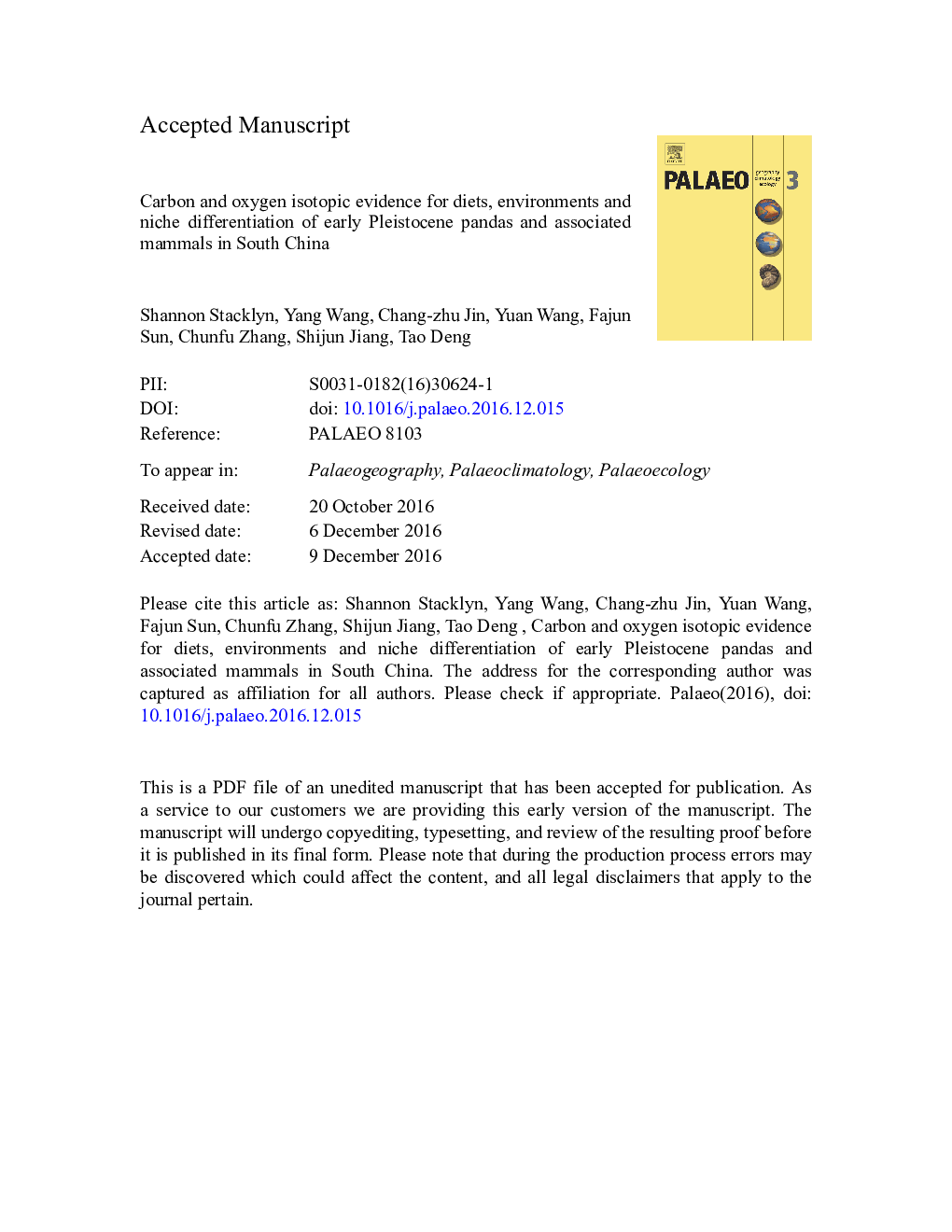| کد مقاله | کد نشریه | سال انتشار | مقاله انگلیسی | نسخه تمام متن |
|---|---|---|---|---|
| 5755781 | 1622124 | 2017 | 39 صفحه PDF | دانلود رایگان |
عنوان انگلیسی مقاله ISI
Carbon and oxygen isotopic evidence for diets, environments and niche differentiation of early Pleistocene pandas and associated mammals in South China
ترجمه فارسی عنوان
شواهد ایزوتوپ کربن و اکسیژن برای رژیم های غذایی، محیط ها و تمایز طعم زود هنگام پانداهای پیلیست اتن و پستانداران مرتبط در جنوب چین
دانلود مقاله + سفارش ترجمه
دانلود مقاله ISI انگلیسی
رایگان برای ایرانیان
کلمات کلیدی
موضوعات مرتبط
مهندسی و علوم پایه
علوم زمین و سیارات
فرآیندهای سطح زمین
چکیده انگلیسی
To better understand the dietary evolution and habitat change of pandas, this study analyzed the stable carbon and oxygen isotope compositions of tooth enamel samples from the early Pleistocene pandas Ailuropoda microta and Ailuropoda wulingshanensis and their associated mammals recovered from Yanliang Cave and Longgu Cave in South China. The enamel δ13C values indicate that mammals living in these cave areas during the early Pleistocene had C3-based diets but some individuals consumed small amounts of C4 grasses. This suggests that C4 grasses were present in the region during the early Pleistocene, likely in patches of open areas (or savanna-woodlands) in a predominantly forested landscape. The δ13C and δ18O data clearly show niche partitioning among panda, pig, and other animals. The pandas had the lowest enamel-δ13C values among all mammals examined, indicating that these early Pleistocene pandas had pure C3 diets composed of plants growing in the understories of closed-canopy forests. A pure C3 diet for these ancient pandas is consistent with an already established dietary niche of bamboo (a C3 plant) in the early Pleistocene. These ancient pandas also had higher δ18O values than all other contemporaneous mammals (except the deer at Longgu Cave), suggesting that they did not drink as much as other large mammals did. The available isotope data suggest that pygmy panda (A. microta) was less ecologically flexible compared to other mammals such as pig, rhino, deer and bovid. The limited ecological flexibility of pygmy panda may have contributed to its demise during climatic fluctuations in the Pleistocene. The reconstructed δ18O values of meteoric water in the study areas during the early Pleistocene are lower than the present-day mean annual precipitation δ18O values in the region, suggesting a wetter climate or stronger summer monsoon in the early Pleistocene than today.
ناشر
Database: Elsevier - ScienceDirect (ساینس دایرکت)
Journal: Palaeogeography, Palaeoclimatology, Palaeoecology - Volume 468, 15 February 2017, Pages 351-361
Journal: Palaeogeography, Palaeoclimatology, Palaeoecology - Volume 468, 15 February 2017, Pages 351-361
نویسندگان
Shannon Stacklyn, Yang Wang, Chang-zhu Jin, Yuan Wang, Fajun Sun, Chunfu Zhang, Shijun Jiang, Tao Deng,
